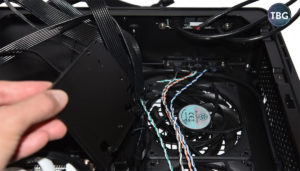SilverStone Raven RVZ01-E ITX Case Review
Pros
Cons
Rating
Introduction
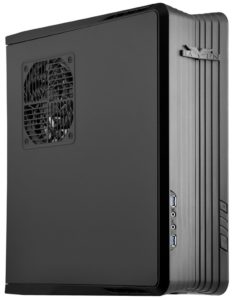 One of the things we set out to do when we founded The Tech Buyer’s Guru back in 2013 was to give ITX builders a place to learn all that there is to know about ITX cases, ITX components, and building ITX systems. That was a lofty goal, and we’re surely not there yet, but with each new ITX case review we do, and with each new hands-on ITX assembly guide we publish, we get closer to seeing the full picture, and we hope that comes through in our coverage.
One of the things we set out to do when we founded The Tech Buyer’s Guru back in 2013 was to give ITX builders a place to learn all that there is to know about ITX cases, ITX components, and building ITX systems. That was a lofty goal, and we’re surely not there yet, but with each new ITX case review we do, and with each new hands-on ITX assembly guide we publish, we get closer to seeing the full picture, and we hope that comes through in our coverage.
And so when we saw the prototype Raven RVZ01-E displayed at CES 2016, our interest was piqued. We reached out to SilverStone as soon as it released the RVZ01-E in the U.S., and they were kind enough to provide a sample for review. Note that the RVZ01-E is not the first case in the Raven family, nor even the first Raven we’ve worked with. It’s a follow-up to the original, groundbreaking RVZ01, and a cousin to the RVZ02, which we dedicated an entire step-by-step assembly guide to. So, is this the ultimate Raven, or has SilverStone messed one too many times with success? Read on to find out!
We’d like to extend a special thank you to SilverStone for providing the SilverStone Raven RVZ01-E ITX Case and SilverStone Strider 850W Platinum Power Supply used in this review. All other components were purchased at retail.
Description and Features
SilverStone markets the RVZ01-E to high-end ITX PC builders looking for a no-compromise solution. It can fit large graphics cards, which are typically necessary for serious gaming, along with CPU coolers up to 83mm tall. That makes it relatively unique among slim cases. It can also fit ATX power supplies, and while SilverStone specifies that units up to 150mm long can be used, it recommends 140mm units (the shortest you’ll find in the ATX market, and made by only a handful of manufacturers). Trust us when we say that SilverStone might as well have spec’d this case for 140mm units only, as no one in their right mind will want to cram a 150mm unit in here!
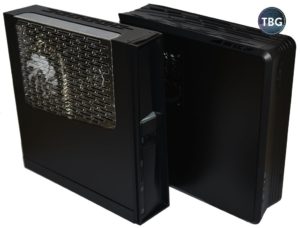
To give readers a sense of the 14-liter RVZ01-E’s size, we’ve placed it next to the 12-liter RVZ02, which many builders would likely think is significantly smaller based on its volume measurement alone. Interestingly, the RVZ02 is actually significantly deeper, and only hits its lower overall volume due to being much narrower. That means the RVZ02 can’t fit the kind of CPU coolers you might want for an overclocked CPU, let alone the ATX power supply we used for this review. But in terms of portability, the RVZ01-E may in fact be the winner. It’s 382mm (W) X 105mm (H) X 350mm (D), versus 380mm (W) x 87mm (H) x 370mm (D) for the RVZ02.
So, the big question is whether the extra width of the RVZ01-E is put to good use. One of the challenges SilverStone had when converting the RVZ01 to the RVZ01-E had to do with cable management. Obviously, an ATX power supply is larger, but it also has longer cables. All this meant that the RVZ01’s front port panel was moved into the GPU section, as can be seen below. This will cause some fitment issues that we’ll discuss on the next page. Also of note: the RVZ01 has a single-chamber design, which means the GPU must be mounted on a tray and then dropped into position. The RVZ02’s major innovation was a dual-chamber design, which allowed direct access to both the CPU and GPU by providing side panels on both sides of the case. But in being as thin as it is, the RVZ02 gives up something critical that the RVZ01-E provides: room for case fans and powerful CPU coolers. The RVZ01-E in fact comes with two slim 120mm fans. As installed from the factory, you get one above the motherboard area and one in the GPU area, although you can install both above the GPU, and we chose to do just that, as shown on the next page.
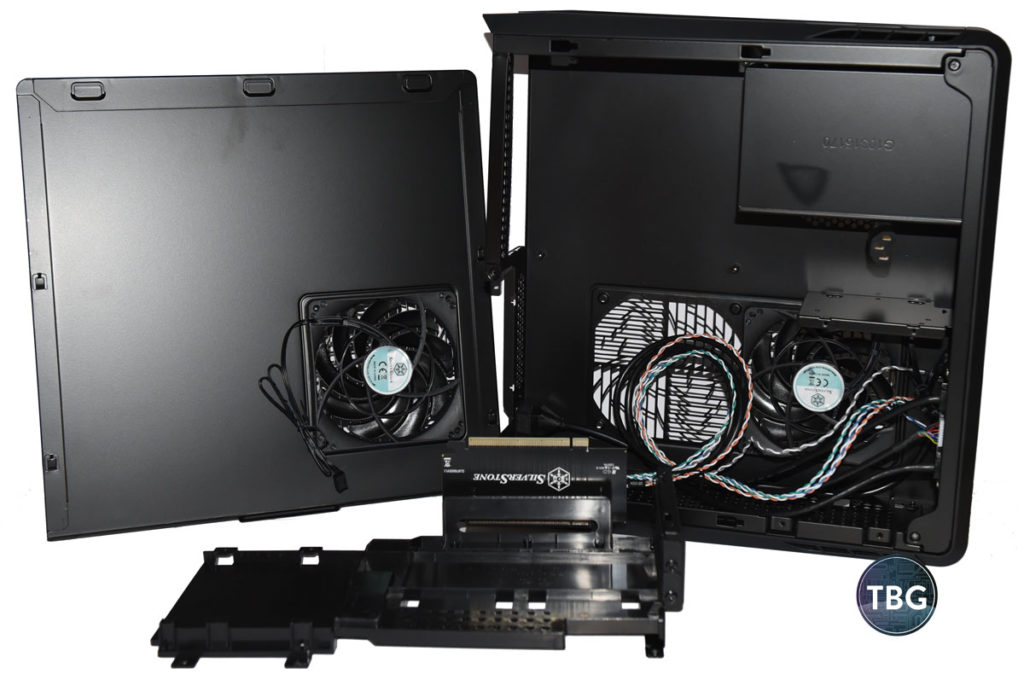
Here are the components we used to put the RVZ01-E case to the test, including many of the same components we used in the RVZ02, but with major changes in the GPU department (given a new generation is upon us!), as well as the PSU, where we use SilverStone’s awesome 850W Platinum-rated ATX unit:
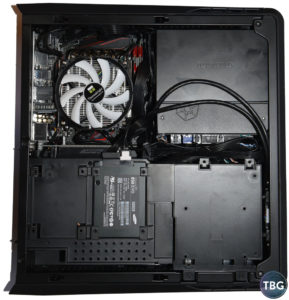
- CPU: Intel Core i5-6600K @ 4.4GHz
- Motherboard: Asus Z170I Pro Gaming
- Memory: Team Vulcan 2x8GB DDR4-3000
- Video Card: EVGA GeForce GTX 1080 SC 8GB
- Solid-State Drive: Samsung 850 Evo 500GB
- Power Supply: SilverStone Strider PS-ST85F-PT
- CPU Cooler: Thermalright AXP-100 Muscle
- Operating System: Windows 10 Home
This is in fact a fairly high-end build, especially with regard to the GPU, but the RVZ01 can definitely take it. The Thermalright CPU cooler we used is one we’ve used before. We knew it could handle this CPU, even overclocked to 4.4GHz as we ran it, so we chose not to switch to another model for this article. One issue with it, however, is its limited clearance above RAM slots and motherboard components. We had to use ultra-low-profile RAM sticks from Team to even utilize the Thermalright AXP-100, which doesn’t say much for its ITX system compatibility. Note that we actually have eight low-profile coolers in for review, including three from SilverStone, and we’ll be publishing a shootout soon. Suffice it to say that it’s nice to have this much choice in the CPU cooler market, but not all slim coolers are created equal!
In case you haven’t noticed yet, the RVZ01-E does not have an optical drive bay. We were never a fan of the slot-loading affair required for the RVZ01, but we actually like the tray-loading drive bay in the RVZ02. All that being said, optical drives are becoming a thing of the past (only three years after Apple declared them dead!), so the omission of an optical drive bay in the RVZ01-E isn’t a serious concern from our point of view. You can always get an external drive like this Samsung model and never worry again about equipping your next PC with an internal drive!
All right, with the basic description out of the way, let’s move on to what really counts: the building process and performance!
Assembly
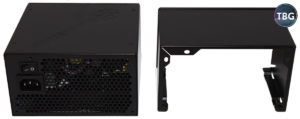
As suggested on the previous page, SilverStone has tweaked an existing design to create the RVZ01-E. And while the trail-blazing video card tray hasn’t seen any changes, the power supply bracket certainly has. As you can see here, you actually need to attach the power supply to the bracket, and then install the bracket in the case. Because the power supply bracket is essentially the same width as the case itself, it screws right into the side panel, which is a little unusual. We’re actually wondering if over time this could warp the thin metal of the side panel, as an ATX power supply is fairly heavy. Note that SilverStone recommends that installation of the power supply be one of the last steps of assembly, and the reason is simple: it’s hard to angle the motherboard into its rear I/O panel if the power supply is already in the case, as there’s practically zero clearance between the board and power supply. That’s not a problem for PSU installation, as it drops right into place.
But that is a problem for cabling, because it means all your cables will be added after the whole system is built, unless you take the unusual step of routing your modular power cables without a PSU installed. We actually recommend this, because many of the decisions you’ll make about where various cables go will depend on where the power cables need to be routed. We have one last helpful tip for builders using the RVZ01-E: don’t forget to flip the main power switch on your PSU before you bolt it into place, because you’ll otherwise have a whole lot of disassembly to do to get your system up and running!
Unfortunately, that’s not where the challenges end with regard to building up a system in the RVZ01-E. At left you can see pictured a combination SSD tray and video card support, borrowed from the original RVZ01. Well, it may have worked in that case, but it does not work here. Not only do you have the video card’s own power cables to contend with, but the RVZ01-E throws two more challenges at you: first there’s the front panel cabling, which is located next to the power supply in the RVZ01, but in this version must snake its way past the SSD tray, and second, the great wall of cables that protrude from the power supply itself. Simply put, this was a challenge like none we’ve ever seen in our many years of PC building, and frankly we gave up. Trying to install that SSD tray right up against the thick power supply cables, while also providing enough space to actually route those cables in various directions is simply impossible. We left the SSD tray out, which meant that our GPU tray was not fully supported.
This, we feel, was a critical error on SilverStone’s part. Even with the shortest ATX power supply on the market, even with using the fewest number of cables possible (one PCIe, one SATA, the 24-pin motherboard cable, and the 8-pin CPU cable), we had a huge mess on our hands. And that’s ignoring the thick USB 3.0 front panel cable that’s a challenge in just about any case.
It was at this point that we actually considered scrapping this review entirely and pulling all our gear out to reinstall it in our trusty RVZ02. But we stopped just short, realizing that we might be able to help out our fellow ITX builders, while giving SilverStone some friendly feedback along the way. So we threw the SSD bracket in the accessory box and pressed ahead with our project, as can be seen below.

With all cables tucked away (using the periphery of the case as much as possible), we were ready to drop our GPU into place. And this was where we met our last challenge: getting it into place while ensuring that no cables got caught up in the fan blades. This step you really must do blind, as you simply cannot see or feel what’s below the GPU once it’s in place. That’s why it’s so important to sort through the cables before you install the video card. Note that while extra-long video cards are in theory supported, even getting our relatively-compact 10.5″ GTX 1080 in place was difficult. Again, this is a problem that wasn’t quite as dire in the original RVZ01, as there were no front panel cables in the GPU area. We also want to make clear that given the loss of the GPU support provided by the SSD tray, our GPU tray was somewhat free to move from side to side, potentially putting pressure on the PCIe riser card and the motherboard’s PCIe slot. The tray is only attached to the top and back of the case as installed, with no attachment points inside the case. While we wouldn’t worry about this for a system that will stay put throughout its life (the video card is essentially suspended from the top of the case, with gravity holding it in place), this certainly isn’t a transport-ready configuration. And that’s a huge shame, because the RVZ01-E is just begging to be taken on the road given its trim dimensions.
Performance
OK, so we had our issues with the build process, but how does this case perform? Well, in a word, great. The CPU has plenty of room to breathe, and while we didn’t use the biggest heatsink possible, that may have been a good thing, as the fan wasn’t pressed right up against a case panel as it is in thinner cases like the RVZ02. The GPU also ran amazingly cool, and this was in part due to the dual 120mm fans blowing directly into it. We will admit, however, that the slim fans SilverStone is using buzz a bit more than we’d like, but that’s typical of such designs. Making matters a bit worse is that the minimum controllable speed of these fans is around 950RPM. That means getting a silent setup isn’t going to be entirely possible. Given a decent enough heatsink on your GPU, however, you really don’t need them.
Another thing that made the cooling situation better in the RVZ01-E than the RVZ02 is that the RVZ01-E has abundant, relatively-unobstructed vents on both ends, allowing the PSU to push hot air out the bottom (if the fan even runs!), while CPU and GPU heat can escape out the back or rise up through the top. And this is one area where having a single chamber might be better than dual chambers: CPU heat doesn’t get stuck in the lower half of the case as it would if there were a solid barrier separating the CPU from the GPU.
Under maximum load, our CPU hit around 72°C, which is great given that it was running at 4.4GHz, while our GPU settled into the typical 74°C-78°C range it hits even in a large ATX case. So, in short, you’re not sacrificing performance with this case, at least if you keep your overclocks to sane levels.
There’s one minor caveat regarding cooling performance we should mention here: SilverStone includes high-quality mesh filters to cover the case’s three fan slots. For builders seriously concerned about dust buildup, this is a great option. But in our testing, these mesh filters obstructed so much airflow that they significantly impacted cooling. In our opinion, lack of airflow is far more dangerous to electronic components than dust (especially SSDs and CPUs), and given this fact, we’re not exactly sure why so many case manufacturers have jumped on the dust filter bandwagon. That’s why we’re glad SilverStone doesn’t pre-install these filters at the factory, instead giving builders the option of installing them if they have a need for extra dust protection.
Conclusion
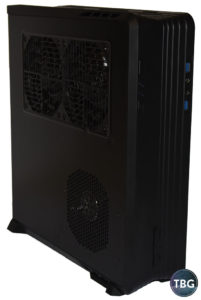 SilverStone is never afraid to iterate, innovate, or push boundaries where necessary. That’s why we are always interested in what they have to offer in the case market. With the RVZ01-E, SilverStone takes a proven, popular case, the RVZ01, drops the costly (and outdated) slot-loading optical drive bay, opens up the space for use by an ATX power supply, and still offers the best cooling you’ll see in a slim console-style ITX case.
SilverStone is never afraid to iterate, innovate, or push boundaries where necessary. That’s why we are always interested in what they have to offer in the case market. With the RVZ01-E, SilverStone takes a proven, popular case, the RVZ01, drops the costly (and outdated) slot-loading optical drive bay, opens up the space for use by an ATX power supply, and still offers the best cooling you’ll see in a slim console-style ITX case.
But SilverStone needed to make quite a few concessions in modifying the RVZ01 to fit ATX power supplies, and to what end? You’ll still need to go with a 140mm model, which basically means SilverStone on the high-end or Corsair on the low-end, and even then you’re stuck with a massive amount of cabling that just doesn’t fit in the RVZ01-E as well as it should. We’ve got to wonder why SilverStone went to all this effort when you could already get great SFX-L units that have more than enough power to support any possible build that would fit in an ITX chassis. In fact, SilverStone makes the very best SFX-L units on the market, so SilverStone already had builders covered there.
In the end, we’re going to call a spade a spade here: the RVZ01-E is an experiment that simply didn’t go quite right. That doesn’t take away from the great achievements SilverStone has already made in the ITX market, and it’s clear that the company wanted to provide a unique, custom case for the niche segment of the PC builder community looking to jam as much wattage as possible into a slim design. We think that’s great, and as long as builders understand what the RVZ01-E is and is not, it’s a good choice. But for anyone new to ITX PCs, or those who simply want the easiest ITX building experience, the RVZ01-E is most definitely not the one.
As of our publication date, the SilverStone Raven RVZ01-E is available for $89.99 shipped free from Amazon. The older Raven RVZ01, which requires an SFX or SFX-L power supply, is $79.99 shipped from Amazon after rebate. We think the RVZ01 is the overall superior design, although our very favorite model in the Raven series is the ultra-slim Raven RVZ02, available for $79.99 shipped from Amazon.
To see our most recent case recommendations in the ITX market, from SilverStone and a host of other manufacturers, check out our Introduction to Building a Small Form Factor PC, updated monthly!


